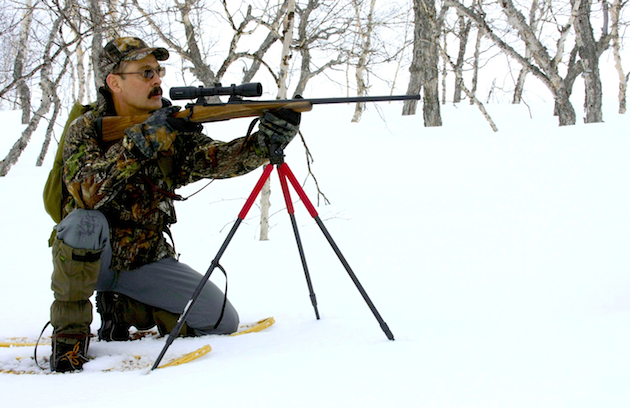From the 2015 Jan./Feb. issue of Sporting Classics.
They resist fashion trends, stay away from black guns, and—thank the Muses—ignore “Euro-styling.” Dakota Arms in Sturgis, South Dakota, builds only classic hunting rifles that work. To heck with hype and fads. Time-tested lines, proven mechanics, and the highest-quality materials drive Dakota. You can keep your plastic drop-box magazines, Picatinny rails, and fall-out glow-stick sights, thank you. Dakota rifles are built to hunt, to shoot, and to last.
For a hunter who grew up on Winchester Model 70s, Remington M700s, and hot-rod Weatherbys, Dakota Arms seems like the new kid on the block, yet they’ve been around for 28 years now. I suspect some young hunters consider Dakotas old-fashioned and stuffy, but any experienced hunter who’s tested, studied, and lived with gun performance in the world’s hunting fields, knows the careful magic that is Dakota. There’s no fat on these rifles, no wasted lines, no superfluous parts. Form follows function, and both are perfection personified.
The lines aren’t just nice or even lovely—they are all that plus quintessentially functional.
Connoisseurs know the history, but just in case: Dakota Arms began as the brainchild of stock-maker Don Allen and his wife, Norma, in the wild and wooly 1970s. In 1986 Allen teamed with master gunsmith Pete Grisel to create the perfect blend of Mauser M98 and pre-64 Winchester M70 function mated to enhanced stock-lines and top-quality walnut in the Dakota Model 76. Those gorgeous stocks cannot be stressed too much when singing the praises of Dakota rifles. The lines aren’t just nice or even lovely—they are all that plus quintessentially functional. Each taper, swoop, swell, and curve contributes to the function a hunter needs to fulfill his mission. And look good doing it. The walnut stocks of a typical Dakota turn heads. The XXX and Exhibition Grade stocks can make artists weep.
As with most new products from new companies, early Dakotas suffered a few glitches, mainly questionable accuracy in some rifles. But over the years, with more consistent barrels and better bedding systems, that got fixed, along with a few minor operational and cosmetic glitches.
After Don and Norma died, a new shop, new equipment, and new manufacturing techniques improved precision, tightened tolerances, strengthened parts, and reduced production time, but the company suffered under poor management.
Fortunately, the dedicated employees—the machinists and stock-makers and finishers who had poured their passions into building and perfecting these rifles—stuck it out until the Freedom Group bought Dakota Arms and invested sufficient funds to clear the backlog, honor commitments, pay debts, and return the company to its well-earned status as one of America’s premiere builders of classic, bolt-action hunting rifles. You might say Dakota today is the American equivalent of Rigby or Holland & Holland.
Some may take umbrage at that claim, for there are other American firms that build high-end classic rifles, including many custom shops and artisans who turn out spectacular rifles. But few approach the array of styles and original actions that Dakota offers.
Dakota may not match the volume of a Remington, Mossberg, or Savage, but those venerable firms can’t match Dakota’s quality—or at least haven’t chosen to.
In addition to the classic Model 76 that launched the company, there is the elegant Model 10 single shot, arguably the finest example of the hammerless Farquharson falling-block style ever built; the lighter, round-body Model 97 bolt-action that retains the controlled round-feed action of the M76 but on a platform that is less expensive to manufacture; the Varminter with a Nesika precision push-feed action; the mini Sharps that is scaled down to 80 percent the bulk of the original; and the Miller falling block, which is famous for target accuracy.
That’s an extensive lineup with a greater selection of rifle actions than many, much larger firms now build. Dakota may not match the volume of a Remington, Mossberg, or Savage, but those venerable firms can’t match Dakota’s quality—or at least haven’t chosen to.
But what might be the future of high-end, classic-style, high-quality bolt actions? Can they compete in today’s $500, MOA bolt-action market? When the average, all-American whitetail hunter can fill his freezer and his season with a budget rifle, how does a Dakota rifle compete? How much demand can there be for a high-priced, high-quality hunting rifle in a down economy and a world where wild lands are shrinking and hunting opportunity along with them?
Time and markets will ultimately answer those questions, but were I placing bets, I wouldn’t bet against a Dakota holding its place. As outdoor adventures become more rare, those lucky enough to indulge in them become more appreciative and more determined to make the most of?each experience. They strive to make their connections with the?natural world, their tastes of humankind’s hunter-gatherer heritage as sweet as possible. Each big game hunt becomes a rare and precious moment. Why share it with just another rifle?
As our population marches inexorably toward 11 billion and our natural connections dim behind the mists of history, each hunt will be more treasured, more savored. We will strive to honor and perfect our rituals, and the perfect, classic rifle will likely be part of that perfection. +++
Be sure to sign up for our daily newsletter to get the latest from Sporting Classics straight to your inbox.

